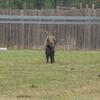Polish wisent arrives in Kraansvlak
Eighteen years after the start of the Wisent Project in the Dutch dunes, a Polish truck arrived again to Kraansvlak. On April 24th 2007 three wisents (a.k.a European bison) arrived from Poland, two cows from the wild population in Białowieża and a bull from Pszczyna. On April 15th 2025 new fresh blood from Poland was added to the herd, a two year old bull.
The young Polish bull has still a few years to go before he reaches adulthood and can procreate successfully. Now is time for him to learn living in the herd of Kraansvlak and gain knowledge about his new environment. In a few years he will take over the position of the current dominant bull, which came two years of age from Germany. This bull also had the chance to take over the wisdom from his predecessor. The dominant bull is mainly the one who will mate with the cows in heat during the mating season and will take care of the next generation.
New habitat
The bull will inhabit the beautiful dune area of Kraansvlak, part of National Park Zuid-Kennemerland, where currently a herd of thirteen wisents lives. Highland cattle, konik horses, fallow deer and roe deer complete the assemblage of large to medium sized herbivores in the area.
Pzsczyna Enclosure
This bull has come together with three other bulls from Pszczyna, a large enclosure of 700 hectares for wisents in the south of Poland. This park has played an important role in the breeding and restitution program of the wisent. Next to this large enclosure is the Visitor Center and Show Farm of Pszczyna with, besides wisents, also red deer, fallow deer, roe deer and foxes. The other three bulls are introduced in other Dutch herds. Read more about Pszczyna: zubry.pszczyna.pl/en/
Translocation of wisents in Europa
Hundred years ago the wisent was extinct in the wild. Due to breeding programs and (re-)introductions the wisent has moved a step upwards on the Red List of the IUCN (International Union for Conservation of Nature) from ‘threatened’ to ‘near threatened’. In 1927 there were only 54 wisents left in captivity. Nowadays there are more than 10.000 living in Europe, most of them in nature areas under semi free circumstances or in the wild in Eastern Europe. By exchanging wisents, mostly bulls, the relatively small subpopulations are held genetically healthy.
International collaboration
Everyone can imagine that the translocation of such a large animal as a wisent is not an easy task. Not only their size but also the complexity of the logistics operation around the movement of a large wild animal are remarkable. And last but not least, all the paper work needed is highly affected by legislation and regulations around the species and its movement between countries, this also does not ease up the process.
This successful translocation was possible thanks to the close collaboration with the European Bison Friends Society, the European Bison Pedigree Book, Ekogrön and FREE Nature. It was financially supported by the European Wildlife Comeback Fund of Rewilding Europe.





